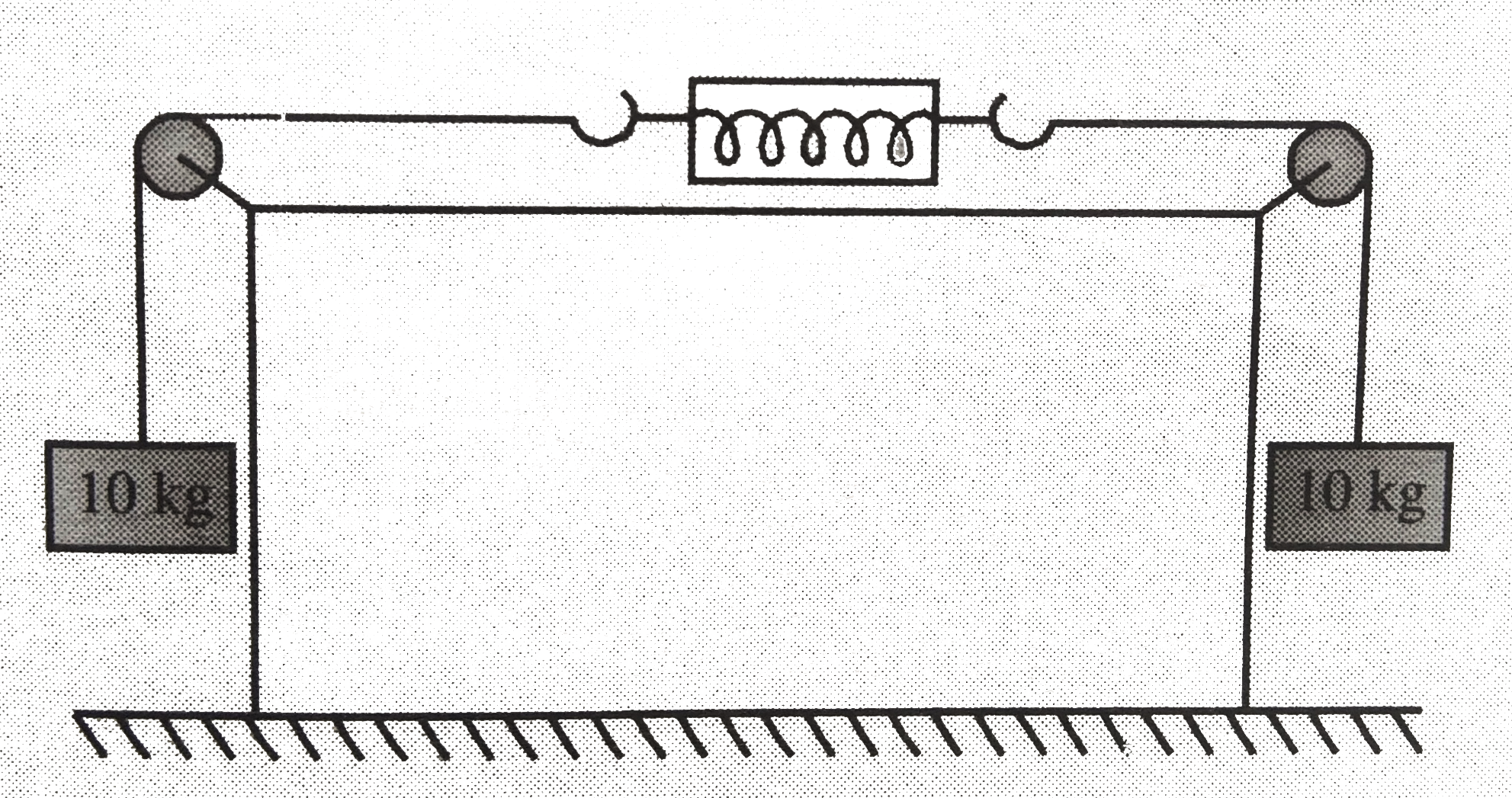A spring balance has a scale that reads from 0 to 50kg. The length of the scale is 20cm. A body suspended from this spring, when displaced and released, oscillates with period of 0.60s. What is the weight of the body?
To solve the problem step by step, we will follow these calculations:
Step 1: Understand the given data
- The maximum mass (m_max) that the spring balance can measure is 50 kg.
- The length of the scale (L) is 20 cm, which is equal to 0.2 m.
- The period of oscillation (T) is given as 0.60 s.
Step 2: Calculate the spring constant (K)
The spring constant can be calculated using the formula for the maximum force (F) exerted by the spring when it is fully stretched, which is equal to the weight of the maximum mass:
F=mmax⋅g
Where:
- g (acceleration due to gravity) is approximately 9.8m/s2
Substituting the values:
F=50kg⋅9.8m/s2=490N
Now, using Hooke's Law, the spring constant K can be calculated as:
K=Fy
Where:
- y is the maximum displacement, which is 0.2 m.
Substituting the values:
K=490N0.2m=2450N/m
Step 3: Relate the period of oscillation to mass
The period of oscillation T of a mass-spring system is given by the formula:
T=2π√mK
Rearranging this formula to find the mass m:
m=T2⋅K4π2
Substituting the known values:
m=(0.60s)2⋅2450N/m4π2
Calculating π2:
π2≈9.87
Now substituting:
m=0.36⋅24504⋅9.87
Calculating:
m≈88239.48≈22.36kg
Step 4: Calculate the weight of the body
The weight W of the body can be calculated using the formula:
W=m⋅g
Substituting the values:
W=22.36kg⋅9.8m/s2
Calculating:
W≈219.1N
Final Answer
The weight of the body is approximately 219.1 N.
---
- The maximum mass (m_max) that the spring balance can measure is 50 kg.
- The length of the scale (L) is 20 cm, which is equal to 0.2 m.
- The period of oscillation (T) is given as 0.60 s.
The spring constant can be calculated using the formula for the maximum force (F) exerted by the spring when it is fully stretched, which is equal to the weight of the maximum mass:
- g (acceleration due to gravity) is approximately 9.8m/s2
- y is the maximum displacement, which is 0.2 m.
The period of oscillation T of a mass-spring system is given by the formula:
The weight W of the body can be calculated using the formula:
The weight of the body is approximately 219.1 N.
Topper's Solved these Questions
Similar Questions
A spring balance has a scale that reads from 0 to 50 kg. The length of the scale is 20 cm. A body suspended from this spring, when displaced and released, oscillates with a period of 0.6s. What is the weight of the body? When 50 kg is put, the extension of spring is 20 cm.
View SolutionA spring balance reads forces in Newton. The scale is 20 cm long and read from 0 to 60 N. Find potential energy of spring when the scale reads 20 N.
View Solution
Knowledge Check
A spring balance has a scale that reads from 0 to 50 kg. the length of the scale is 20 cm. a block of mass m is suspended from this balance, when displaced and released, it oscillates with a period 0.5 s. the value of m is (Take g=10ms−2)
A8 kgB12 kgC16 kgD20 kg
A spring elongated by length 'L' when a mass 'M' is suspended to it. Now a tiny mass 'm' is attached and then released, its time period of oscillation is -
View SolutionA body of mass m is suspended from three springs as shown in figure. If mass m is displaced slightly then time period of oscillation is

View SolutionIf the same weight is suspended from three springs having length in the ratio 1 : 3 : 5 , the period of oscillations shall be the ratio of
View SolutionA force of 6.4 N stretches a vertical spring by 0.1 m. The mass (in kg) that must be suspended from the spring so that it oscillates with a time period of π4 second.
View SolutionWhen a mass of 5 kg is suspended from a spring of negligible mass and spring constant K, it oscillates with a periodic time 2π. If the mass is removed, the length of the spring will decrease by
View SolutionA body of mass m is attached to the lower end of a spring whose upper end is fixed. The spring has negligible mass. When the mass m is slightly pulled down and released, it oscillates with a time period of 3s. When the mass m is increased by 1kg, the time period of oscillations becomes 5s. The value of m in kg is
View Solution(a) A 10-kg block is supported by cord that runs to a spring scale, which is supported by another cord from the ceiling as shown in fig. What is the reading on the scale?

(b) In Fig. the block is supported by a cord that runs around a pulley and to a scale. The opposite end of the scale is attached by a cord to a wall. What is the reading of the scale?

(c ) In fig. the wall has been replaced with a second 10-kg block, what is the reading on the scale now?
 .
.
View Solution
